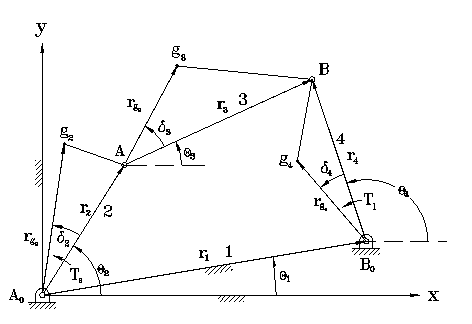

Given position, velocity, acceleration, and inertia properties such as mass and mass moment of inertia for each moving link of a four-bar linkage, we are able to perform force analysis for the linkage. Three static equilibrium equations, in terms of forces in the X and Y directions and moment about the center of gravity of the link, can be written for each link. The free body diagram is also available. For link 2, we get
F12x + F32x + Fg2x = 0 (1) -m2g + F12y + F32y + Fg2y = 0 (2) Ts + (-rg2) x F12 + (r2-rg2) x F32 + Tg2 = 0 (3)
F23x + F43x + Fg3x = 0 (4) -m3g + F23y + F43y + Fg3y = 0 (5) (-rg3) x F23 + (r3-rg3) x F43 + Tg3 = 0 (6)
F34x + F14x + Fg4x = 0 (7) -m4g + F34y + F14y + Fg4y = 0 (8) (-rg4) x F14 + (r4-rg4) x F34 + Tg4 + Tl = 0 (9)
Ts - rg2*cos(theta2+delta2)*F12y + rg2*sin(theta2+delta2)*F12x + [r2*cos(theta2) - rg2*cos(theta2+delta2)]*F32y - [r2*sin(theta2) - rg2*cos(theta2+delta2)]*F32x + Tg2 = 0 (10) -rg3*cos(theta3+delta3)*F23y + rg3*sin(theta3+delta3)*F23x + [r3*cos(theta3) - rg3*cos(theta3+delta3)]*F43y - [r3*sin(theta3) - rg3*cos(theta3+delta3)]*F43x + Tg3 = 0 (11) -rg4*cos(theta4+delta4)*F14y + rg4*sin(theta4+delta4)*F14x + [r4*cos(theta4) - rg4*cos(theta4+delta4)]*F34y - [r4*sin(theta4) - rg4*cos(theta4+delta4)]*F34x + Tg4 + Tl = 0 (12)
Ax = b (13)
The interface below allows the user to find the joint forces and the required input torque given the link lengths, theta1, one additional position, one angular velocity, one angular acceleration, the external load and the inertia properties for the mechanism.
